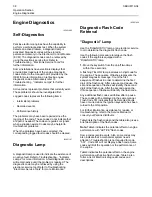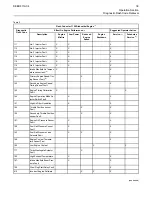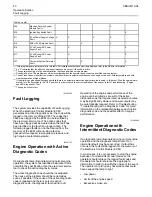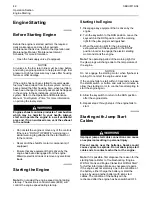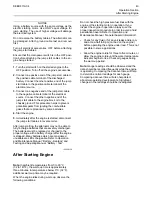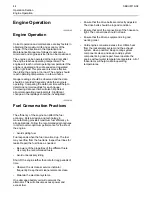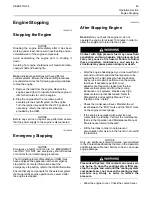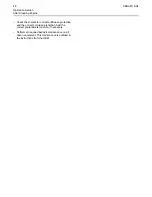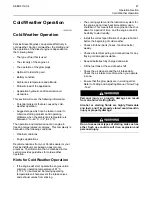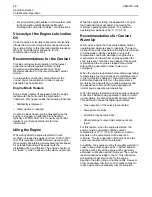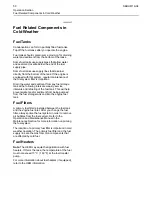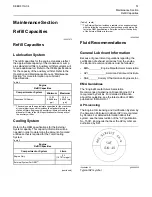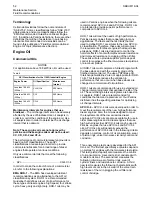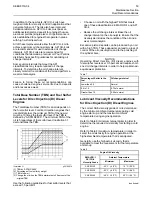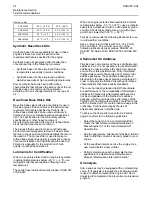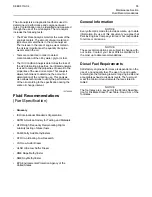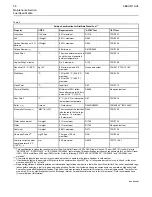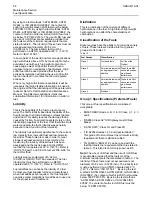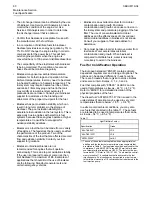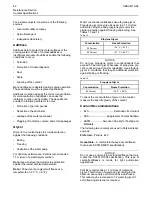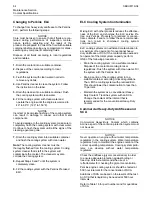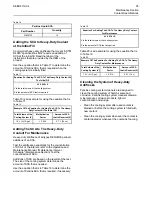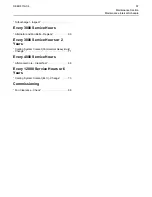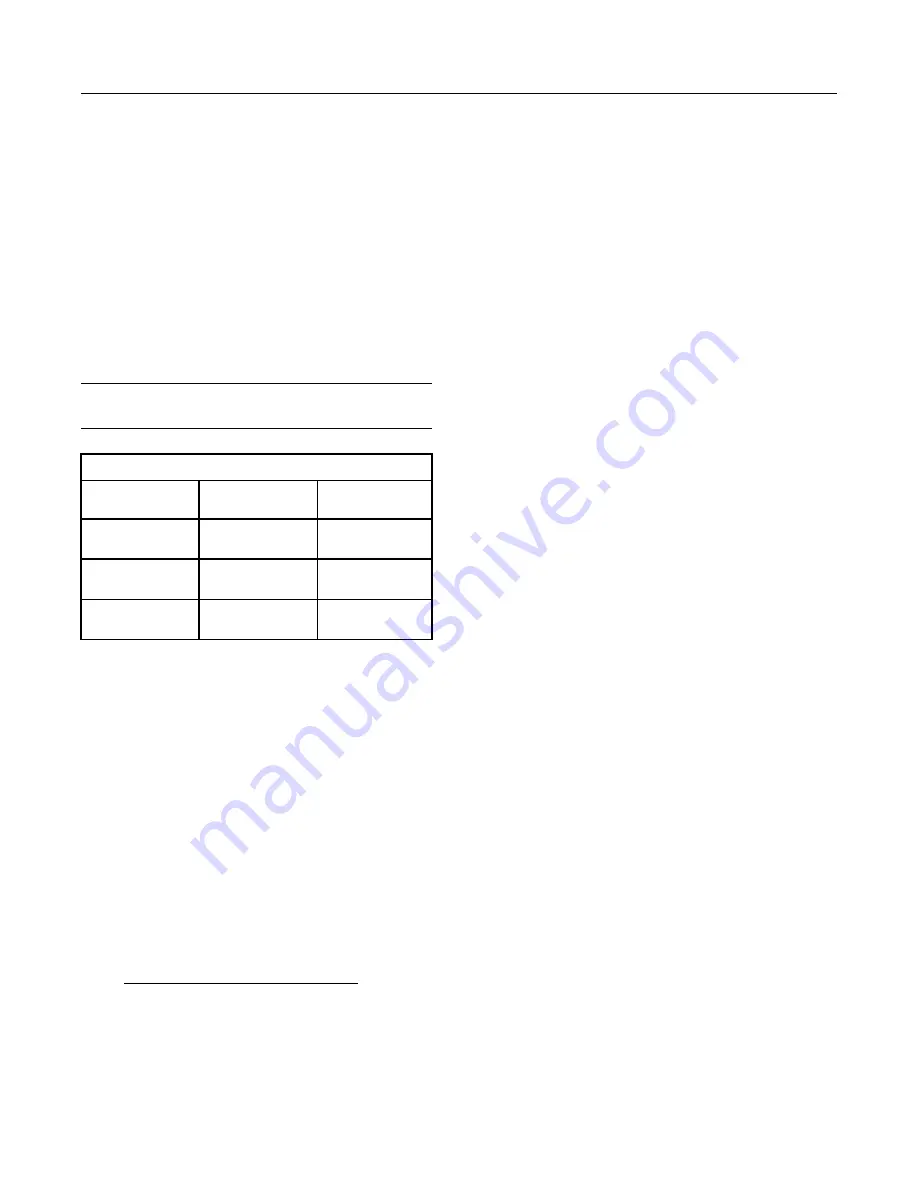
Terminology
Certain abbreviations follow the nomenclature of
“SAE J754”. Some classifications follow “SAE J183”
abbreviations, and some classifications follow the
“EMA Recommended Guideline on Diesel Engine
Oil”. In addition to Perkins definitions, there are other
definitions that will be of assistance in purchasing
lubricants. Recommended oil viscosities can be
found in this publication, “Fluid Recommendations/
Engine Oil” topic (Maintenance Section).
Engine Oil
Commercial Oils
NOTICE
For applications above 168 kWCI-4 oil must be used.
Table 6
API Classifications for the 1106D Industrial Engine
Engine Power
Oil Specification
Maintenance
Interval
Less than 168 kW
(225 hp)
CH-4/CI-4
500 Hours
More than 168 kW
(225 hp)
CI-4
500 Hours
Less than 168 kW
(225 hp)
CG-4
250 Hours
Maintenance intervals for engines that use
biodiesel
– The oil change interval can be adversely
affected by the use of biodiesel. Use oil analysis in
order to monitor the condition of the engine oil. Use
oil analysis also in order to determine the oil change
interval that is optimum.
Note: These engine oils are not approved by
perkins and these engine oils must not be used:
CC, CD, CD-2 and CF-4.
The performance of commercial diesel engine oils is
based on API classifications. These API
classifications are developed in order to provide
commercial lubricants for a broad range of diesel
engines that operate at various conditions.
Only use commercial oils that meet the following
classifications:
• API
CH-4 CI-4
In order to make the correct choice of a commercial
oil, refer to the following explanations:
EMA DHD-1
– The EMA has developed lubricant
recommendations as an alternative to the API oil
classification system. DHD-1 is a Recommended
Guideline that defines a level of oil performance for
these types of diesel engines: high speed, four stroke
cycle, heavy-duty and light duty. DHD-1 oils may be
used in Perkins engines when the following oils are
recommended: API CH-4 and API CG-4. DHD-1 oils
are intended to provide superior performance in
comparison to API CG-4.
DHD-1 oils will meet the needs of high performance
Perkins diesel engines that are operating in many
applications. The tests and the test limits that are
used to define DHD-1 are similar to the new API CH-
4 classification. Therefore, these oils will also meet
the requirements for diesel engines that require low
emissions. DHD-1 oils are designed to control the
harmful effects of soot with improved wear resistance
and improved resistance to plugging of the oil filter.
These oils will also provide superior piston deposit
control for engines with either two-piece steel pistons
or aluminum pistons.
All DHD-1 oils must complete a full test program with
the base stock and with the viscosity grade of the
finished commercial oil. The use of “API Base Oil
Interchange Guidelines” are not appropriate for DHD-
1 oils. This feature reduces the variation in
performance that can occur when base stocks are
changed in commercial oil formulations.
DHD-1 oils are recommended for use in extended oil
change interval programs that optimize the life of the
oil. These oil change interval programs are based on
oil analysis. DHD-1 oils are recommended for
conditions that demand a premium oil. Your Perkins
distributor has the specific guidelines for optimizing
oil change intervals.
API CH-4
– API CH-4 oils were developed in order to
meet the requirements of the new high performance
diesel engines. Also, the oil was designed to meet
the requirements of the low emissions diesel
engines. API CH-4 oils are also acceptable for use in
older diesel engines and in diesel engines that use
high sulfur diesel fuel. API CH-4 oils may be used in
Perkins engines that use API CG-4 and API CF-4
oils. API CH-4 oils will generally exceed the
performance of API CG-4 oils in the following criteria:
deposits on pistons, control of oil consumption, wear
of piston rings, valve train wear, viscosity control and
corrosion.
Three new engine tests were developed for the API
CH-4 oil. The first test specifically evaluates deposits
on pistons for engines with the two-piece steel piston.
This test (piston deposit) also measures the control
of oil consumption. A second test is conducted with
moderate oil soot. The second test measures the
following criteria: wear of piston rings, wear of
cylinder liners and resistance to corrosion. A third
new test measures the following characteristics with
high levels of soot in the oil: wear of the valve train,
resistance of the oil in plugging the oil filter and
control of sludge.
52
SEBU8119-04

